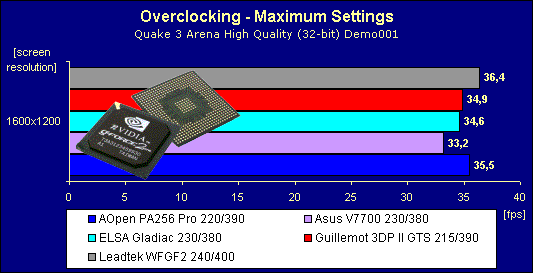Blue Wonder? The Guillemot/Hercules 3D Prophet II GTS
Overclocking Chip And Memory
From the start we were interested whether the additional heat sinks on the memory chips boosts the overclocking capabilities of the 3D Prophet II GTS. In a five-hour test we went through all the possible settings. But before you look at the results, you should know that there are slight deviations in the quality of the memory chips due to the production process. The board design and the cooling of the graphics chips also influence the overclocking capabilities. All following results refer to the cards we tested. However, slight changes might occur on your model.

First, we slowly increase the chip clock, and test the card with Quake 3 at high resolution to reach the bandwidth limit. Unfortunately we soon realized that the buck stopped at 215 MHz. All other contestants reached higher numbers. But the chip clock is not the deciding factor, as you will find out later. Next we slowly increase the memory clock. At 355 MHz we observed the so-called pixel noise, that manifest themselves as small white dots on the screen. The 3D Prophet II GTS ran stable up to a clock frequency of 390 MHz, even over a longer time period. However, everybody needs to decide for him or herself whether he or she wants to live with the pesky pixel noise. The result: the heat sinks on the memory chips do not accomplish much. Our hot overclocking monster is still the Leadtek Winfast GeForce2. Note: At a memory clock of 390 MHz we again tried to increase the chip clock - unfortunately without success.
Stay on the Cutting Edge
Join the experts who read Tom's Hardware for the inside track on enthusiast PC tech news — and have for over 25 years. We'll send breaking news and in-depth reviews of CPUs, GPUs, AI, maker hardware and more straight to your inbox.
Current page: Overclocking Chip And Memory
Prev Page Full Scene Anti-Aliasing Next Page Overclocking Chip And Memory, Continued
